Localized Narratives in “Pan-Asia”
Tokyo can seem like shorthand for ‘the Japanese art world’, as it has long played host to most of the country’s main art schools, galleries, fairs, auctions; it once had its own biennale, and the ‘Yokohama’ triennale is really just a few more stops away on the Tokyo metro. But dimensions of Japanese art happening beyond Tokyo’s borders, such as Yuko Iida’s recent solo exhibition, “An Uneasy Journey through Asia”,1 at the Star Gallery, point to interesting shifts in ‘Japanese art’, now.
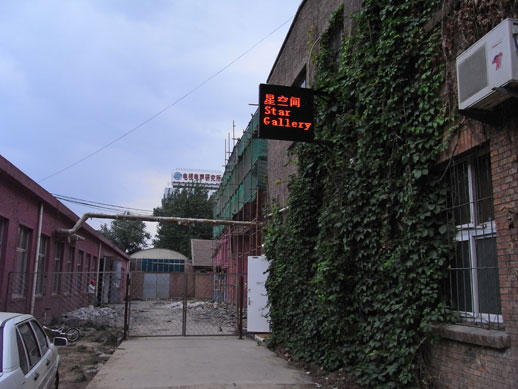
Why? Well, if you haven’t been to the Star Gallery that might be because it’s in Beijing. And if you haven’t seen Iida’s work, that could be because she has spent many of the last ten years as living in Beijing, at first as student and now as a practicing artist.
Though still relatively few, Iida is one of a growing number of Japanese artists based in China, in an increasingly international scene of art practitioners (not simply galleries or buyers) coming from overseas to study and/or practice their art in Beijing, Shanghai and other major cities. Many recently arrived artists have followed the boom or bubble of the Chinese art-market in the last three to four years; some staying on after completing one of the artist-in-residence programs now offered by a handful of galleries or museums. On the other hand, some artists like Iida are becoming integral parts of the local scene, with its increasingly global reputation.
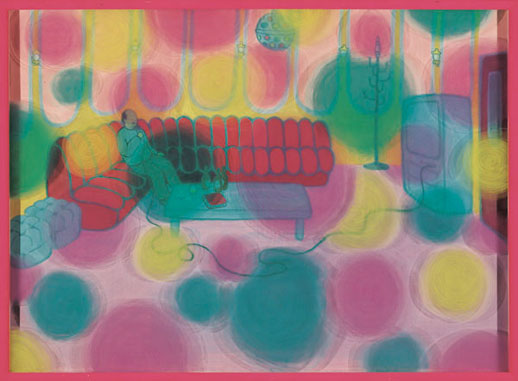
Iida first came to China for a short trip in 1993, returning early the next year to study. She eventually entered the Central Academy of Fine Arts (CAFA), Beijing, the equivalent of Tokyo’s University of the Arts,2 and graduated with a BFA in painting in 1999. Briefly returning to Japan, she organized a couple of small solo exhibitions, such as her 2006 show at Youkobo Art Space. This was the fruit of a year-long study trip to Korea under a Pola Art Foundation scholarship, which first allowed her to develop some of the themes that find greater articulation in the more recent series shown at the Star Gallery. After her time in Korea, she returned to Beijing to complete the three-year MFA program in painting at CAFA, completed in 2007, and remains based in Beijing.
“An Uneasy Journey through Asia” is a series of artworks drawing on Iida’s concerns toward the recent and ongoing changes in East Asian countries. Specifically, the artist draws on her time spent in Japan, China, Korea and Taiwan presenting stylized scenes, usually of life in the major cities. Each of these places is on the one hand generically ‘Asian’ and yet most are expressed using specific visual references with localized significance: a betel nut vendor in Taiwan, an assortment of panchan on a low-set table in a Korean diner, a display of plastic petrified food one sees in front of many a Japanese restaurant…
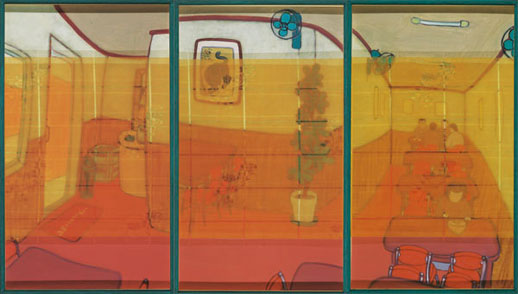
This aspect of Iida’s work, addressing her subject at the level of everyday life in major cities, is significantly different to identifying representative cultural icons – despite some occasional overlap. In interviews, Iida has discussed her habit of wandering around and taking photos, especially through Beijing streets. She is drawn to the city life seen through shop and café windows; to electric signage, old arcades, karaoke rooms, tiny noodle shops or the large round tables of banquet-style Chinese restaurants. She often depicts areas considered old or rundown, like Tokyo’s shitamachi, where the recent buzz of crowds lingers in an atmosphere somewhere between the renaissance of nostalgia and the oblivion of ‘re-development’.
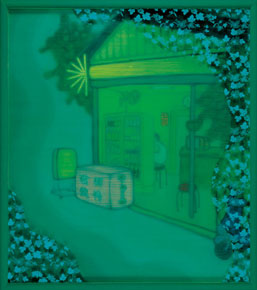
Unlike some of Iida’s earlier work, nearly all of the images in this series depict actual places, drawn from the artist’s experiences. Yet Iida’s consistent simplicity and taste for non-descript places makes it difficult to distinguish between one place and another. On one level this can lead to a subtle ‘pan-Asian’ sentiment being read into her work, as suggested in some of the exhibition catalogue essays for example. Yet such readings downplay the personal aspects of this “uneasy journey”, in favour of identifying a grander narrative of Asian solidarity, or some kind of dubious ‘essentially’ Asian experience. In a separate interview, Iida clearly indicated her concerns for what she feels is a cultural degradation or crises amidst an ongoing confrontation between Japanese or [East] ‘Asian’ culture and “the West”. However, the visual ambiguity between the images in this series seems to reflect the artist’s interrogation of this ‘imagined community’ of Asia, based on personal journeys, through which she has challenged her own assumptions, as well as those of the grand narratives.
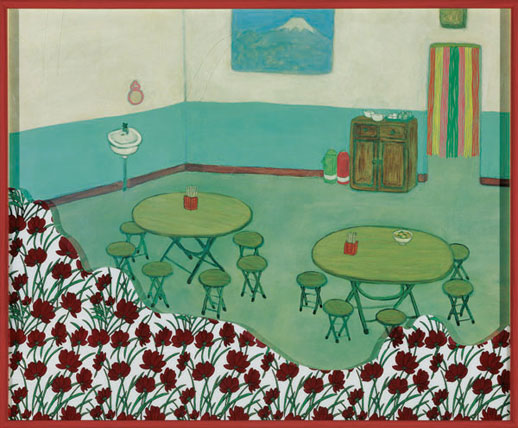
In Fuji-san (2008) for example, a picture of Mt. Fuji – an iconic symbol of Japan – hangs on the wall of a sparse diner. This would seem to locate the picture firmly in ‘Japanese’ space. Yet the table settings, white ceramics and fluorescent thermoses (usually filled with boiling water) all suggest a typical inexpensive Chinese diner. A picture of Mt Fuji on the wall of a cheap diner in China? A Chinese restaurant in Japan, perhaps? And if it were – would that make this image of ‘Asia’ any more ‘accurate’? Such are the questions lying beyond the banality of identifying culturally specific iconographies. Instead, Iida uses a refined palette of details with personal and local significance which, despite the bright colours and seemingly muted hum of her encased pictures, speaks strongly about the contemporary “ugliness” 3 of everyday life.
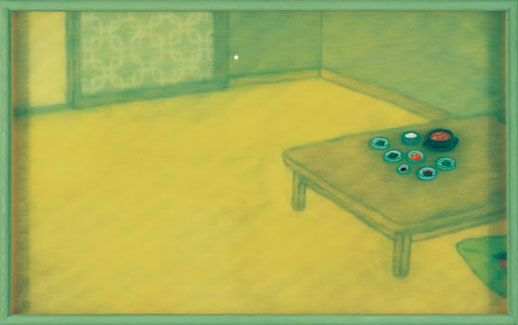
Although quite rightly translated as “uneasy”, it is interesting to consider the ‘bu an (Chn.) / fu an (Jpn.)’ of Iida’s title in terms of ‘unsettling’ or ‘uncanny’. Much of the aesthetic that fascinates this artist has developed during the 70s, 80s, and 90s – boom periods for Japan, Korea and China, respectively. In many instances the shop-fittings, hybrid fashions, neon signage and makeshift designs were quick, interim affairs and have since been renovated or ‘upgraded’. For a generation or two that grew up amidst this rapid economic and urban development, there is a kind of nostalgia surrounding areas of cities such as Beijing, Seoul or Tokyo, which are relatively recent, but have become rundown while other areas of the city are being re-developed have been developed. Though they are old parts of the city, yet they are seldom considered culturally or historically significant.
Iida’s work is indicative of a larger trend in many recent developments in the Japanese art scene. It should be noted that many Japanese artists are also active in other major cities like New York, London or Berlin, for the proximity of these cities to the market, collectors, a vibrant gallery network and major schools. Alongside this phenomena, one mustn’t forget the significance of Tokyo’s new art-fair — 101Tokyo — with its specifically international and contemporary approach; as well as the recent opening of both ‘Mizuma & One’ and ‘Y++’ [y double plus] in Beijing, run by the Tokyo-based Mizuma Gallery and Wada Fine Arts respectively. For her part, Iida made it clear that her choice was not merely professional but also a reaction to certain limits she feels confronted with in Japan. Whether such sentiments underlie other such outwardly mobile shifts in the Japanese scene remains conjecture, however considered together they certainly indicate that various strata within current Japanese art — students, practicing artists, galleries and collectors — are increasingly willing to look beyond the assumed boundaries of ‘Japanese art’. Watch this space…
—
1 Iida Yuko’s ‘An Uneasy Journey through Asia’, original Chinese title 亜州不安之旅, was held at the Star Gallery, Chinese name, 星空間, located in the 798 art district of Beijing, from June 1 – 26, 2008. See www.stargallery.cn for gallery details.
2 This is the English name of Tokyo Geijutsu Daigaku, recently changed from ‘Tokyo National University of Fine Arts and Music’. In Chinese CAFA is 中央美術学院.
3 Iida specifically uses the Chinese word 難看 nankan, which can be rendered as ‘ugly’, in addition to 不安, to refer to rapid, often ill-considered urban developments that are commonplace in cities such as Beijing. In a recorded interview, June 2008.
Olivier Krischer
Olivier Krischer



